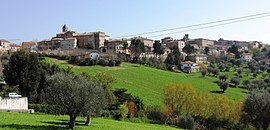Ostra (brands)
| Ostra | ||
|---|---|---|

|
|
|
| Country | Italy | |
| region | Brands | |
| province | Ancona (AN) | |
| Coordinates | 43 ° 37 ' N , 13 ° 10' E | |
| height | 188 m slm | |
| surface | 46.59 km² | |
| Residents | 6,544 (Dec. 31, 2019) | |
| Population density | 140 inhabitants / km² | |
| Post Code | 60010 | |
| prefix | 071 | |
| ISTAT number | 042035 | |
| Popular name | Ostrensi | |
| Patron saint | San Gaudenzio | |
| Website | Ostra | |
 Ostra |
||
Ostra is an Italian commune with 6544 inhabitants (as of December 31, 2019) in the province of Ancona , 35 km from Ancona . The distance from the nearest major city Senigallia on the Adriatic coast is 14 kilometers by road.
Districts, surroundings and neighboring communities
In addition to the old town of Ostra, which is 188 meters above sea level, the municipality includes the districts of Casine, Pianello and Vaccarile. The area around Ostra is a typical Italian wine country that is characterized by agriculture. The neighboring communities are Belvedere Ostrense , Corinaldo , Montecarotto , Ostra Vetere , Senigallia and Trecastelli . Lorenzo Cioccolanti has been mayor (1999–2009) since the turn of the millennium, followed by Massimo Olivetti (2009–2014) and Andrea Storoni (2014–2019). Federica Fanesi has been mayor ( Lista civica di centro-destra , part of Forza Italia ) since June 2019 .
history
The origin of Ostra in the early period of the Roman Empire is not documented, but it is certain that the place already existed at the time of Emperor Augustus (31 BC - 14 AD). The immigrant Germanic Visigoths destroyed the village in 410 AD; the ruins are still visible today in Muracce near Ostra Vetere. The population fled the destroyed settlement and founded a new settlement called Montalboddo on Mount Bodio, property of a Roman . The actual year of birth of the municipality is considered to be 1194, when the Archbishop of Ravenna confirmed the establishment of Montalboddo as a corporation with the Treaty of Capitula Comunis , but at the same time established the rule of the bishop over the municipality. A few years later, in an uprising, the citizens of Montalboddo succeeded in throwing off this domination and becoming independent under the protection of the Roman Curia .
From the middle of the 13th century, Motalboddo came under the rule of the city of Jesi for almost a hundred years . Then it came to changing domination by several noble families until Montalboddo in 1454, the direct management by the Papal States surrendered. This resulted in a noticeable upswing; But there were also disputes between the noble families up to a corresponding peace treaty in 1574. From around 1700, the community experienced a time of peace and prosperity, in which the noble families embellished their buildings, the citizenship built the town hall ( Palazzo comunale ) and the religious orders built monasteries, which were decorated with paintings, stucco work and works of art. As the crowning glory of this time, Pope Pius VI. on July 30, 1790 the municipality of Montalboddo was granted town charter .
After the re-establishment of the Kingdom of Italy, the city was admitted to the kingdom under King Vittorio Emanuele II in 1860, and the later King Umberto I approved by decree on May 12, 1881, the citizens' demand to rename the city name to Ostra instead of Montalboddo. In autumn 2003 the town twinning between Ostra and the Upper Bavarian market town of Markt Schwaben east of Munich was initiated by the then Markt Schwaben mayor.
tourism
Since 2003 the city of Ostra has had the orange flag of the Italian Touring Club, a quality award for the tourist environment of small inland communities.
Regular events
- The national arts and crafts and antiques fair, held every year in the first week of August in the historic rooms of the Palazzo dei Padri Conventuali .
- The international poetry competition Angelica Catalani , which has been based in Ostra since the 1990s.
- The night of ghosts and ghosts ( Notte dei sprevengoli ), which takes place during Halloween on the last weekend in October. Here streets, squares and large houses in the countryside and in small towns are decorated in an unusual horror style. According to local folk tradition, the Sprevengoli are ghosts that disturb people while they sleep; they are to be distributed through this event.
- The annual fair that has been held in October since 1670 on the day of the Ostra patron, San Gaudenzio .
- The weekly market day, which always takes place on Friday.
There are the following main folk festivals:
- The "Festival of the rabbit in the suckling pig", which always takes place at the beginning of June in the Vaccarile district .
- The " Tagliatelle with wild boar festival " organized by the Catholic labor movement in the Casine district in the first week of August .
- The "Ostrawelt" festival, which is organized on the Piazza dei Martiri (Martyrs' Square, in front of the town hall) in the week after the ribbon noodle festival.
- The “Passatello Pasta Festival”, which takes place on the last weekend of July in the Pianello district .
- The "Festival of Lights and Taste" on St. Martin's Day, which takes place on the 2nd weekend in November in the Pianello district .
Web links
- http://www.comune.ostra.an.it Homepage of the municipality of Ostra
Individual evidence
- ↑ Statistiche demografiche ISTAT. Monthly population statistics of the Istituto Nazionale di Statistica , as of December 31 of 2019.
- ↑ Brochure "Città di Ostra" of the Ufficio Turistico in Ostra (2016)
- ↑ Leaflet "Ostra città / paese" of the Ufficio Turistico in Ostra (2016)

